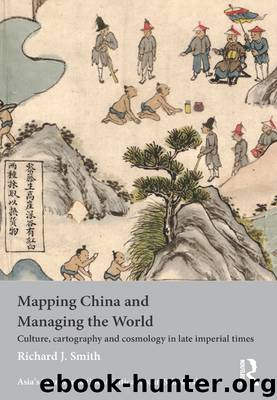Mapping China and Managing the World by Smith Richard J

Author:Smith, Richard J.
Language: eng
Format: epub
ISBN: 9781136209215
Publisher: Taylor & Francis (CAM)
Of the literally dozens of stories on dream divination in the Qingbai leichao, no less than ten focus on “praying for dreams.” Significantly, most of the individuals involved in seeking them are highly reputable scholars—among them, such Qing notables as Li Guangdi (1642–1718), Jiang Yi (1631–1687), Zhang Ying (1638–1708), and Xu Ben (1683–1747).47
Most Chinese believed that the physical appearance of individuals could yield important clues regarding both character and destiny.48 Elites as well as commoners held this view. John Gray writes, for instance, “It is surprising to find what a number of respectable and influential men throughout the empire resort to professors of the art [of physiognomy].”49 The Qingbai leichao, local gazetteers, and other sources indicate that a great many Qing civil and military officials relied on physi-ognomers for advice, and a number of Chinese scholars actually practiced the art—including such high-ranking individuals as Ji Huang (1711–1794), Zeng Guofan (1811–1872), Shen Baozhen (1820–1879), Liu Mingchuan (1836–1896), Li Wentian (1834–1895), and Zhao Shuqiao (d. 1900).50
The social importance of impressive features in Qing China can scarcely be underestimated. In the first place, physiognomic stereotypes unquestionably influenced the way people at all levels responded to one another. These stereotypes were reinforced not only in popular proverbs but also in folktales and novels. At least some almanacs, like all physiognomy manuals, depicted different types of faces, as did public displays that advertised the skills of professional physiognomers “with painted representations of the human countenance.”51 Facial stereotypes could even affect a person's bureaucratic career. A middle degree holder (juren), for example, could reportedly enter Qing official life at a comparatively high level after failing the jinshi examination three times if he possessed what was considered to be the right kind of face.52 Professional physiognomers generally focused primary attention on the hands and basic facial characteristics of their clients (ears, forehead, eyebrows, eyes, nose, cheeks, mouth, chin, and complexion), but they might also pay attention to other parts of the body, as well as movements, vocal sounds, and even urine and excrement.53
Closely related to physiognomy in its emphasis on visual interpretation (xiang) was the art of fathoming or dissecting written characters, a technique employed not only as a separate category of divination but also in conjunction with dream analysis.54 The great Qing scholar Ji Yun (1724–1805) once described the omens of word analysis as developing from the same sort of spiritual communication as the selection of milfoil stalks in Yijing divination or the use of oracle bones.55 For the convenience of illiterate or semiliterate commoners, professional fortune-tellers provided a limited number of characters to be chosen by clients and interpreted, but elites generally wrote their own word choice down. The logic of word analysis, like that of dream interpretation, physiognomy, and most other forms of Chinese divination, was inveterately associational, allowing, perhaps even compelling, diviners to link all relevant concepts, cosmological as well of personal, to the client. Stories surrounding the dissection of characters circulated widely in Qing China, and many involved famous scholars and officials such as Zhang Ying, adviser to the Kangxi emperor.
Download
This site does not store any files on its server. We only index and link to content provided by other sites. Please contact the content providers to delete copyright contents if any and email us, we'll remove relevant links or contents immediately.
| Anthropology | Archaeology |
| Philosophy | Politics & Government |
| Social Sciences | Sociology |
| Women's Studies |
Cecilia; Or, Memoirs of an Heiress — Volume 1 by Fanny Burney(32487)
Cecilia; Or, Memoirs of an Heiress — Volume 2 by Fanny Burney(31905)
Cecilia; Or, Memoirs of an Heiress — Volume 3 by Fanny Burney(31883)
The Great Music City by Andrea Baker(31749)
We're Going to Need More Wine by Gabrielle Union(18996)
All the Missing Girls by Megan Miranda(15748)
Pimp by Iceberg Slim(14430)
Bombshells: Glamour Girls of a Lifetime by Sullivan Steve(14016)
For the Love of Europe by Rick Steves(13446)
Talking to Strangers by Malcolm Gladwell(13279)
Norse Mythology by Gaiman Neil(13262)
Fifty Shades Freed by E L James(13182)
Mindhunter: Inside the FBI's Elite Serial Crime Unit by John E. Douglas & Mark Olshaker(9257)
Crazy Rich Asians by Kevin Kwan(9209)
The Lost Art of Listening by Michael P. Nichols(7446)
Enlightenment Now: The Case for Reason, Science, Humanism, and Progress by Steven Pinker(7268)
The Four Agreements by Don Miguel Ruiz(6689)
Bad Blood by John Carreyrou(6579)
Weapons of Math Destruction by Cathy O'Neil(6201)
